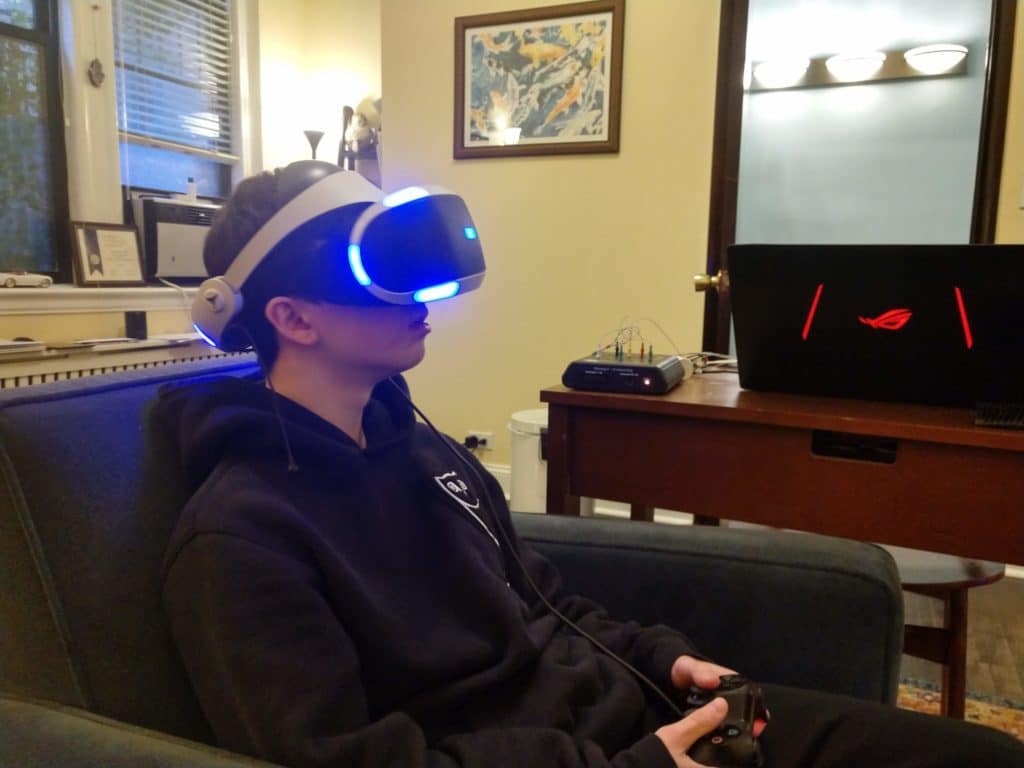
Americans are no strangers to anxiety. In fact, it’s the most common mental disorder in the country and affects around 40 million people over the age of 18. Sadly, it’s starting to affect more children and teens too. Luckily, virtual reality therapy is a modern way to address anxiety disorders. At Sachs Center, we offer virtual reality therapy for individuals in New York suffering from anxiety.
Everybody experiences some kind of anxiety from time to time, that’s a natural part of the human survival instinct. It only becomes a problem when it lingers long after any hint of danger has passed.
Living with anxiety means trying to go through every day in a constant state of fear. Left untreated, anxiety can escalate into full-blown panic attacks, and is often accompanied by increasing depression.
Fortunately, treatment for anxiety is readily available.
Virtual reality therapy for anxiety disorders is one of the latest ways to soothe this crippling state of mind.
Contact us to learn how we can help you with your anxiety with our unique approach to therapy in New York: VR for anxiety disorders.
What is Virtual Reality Therapy for Anxiety Disorders?
Virtual reality therapy is the modern-day equivalent of exposure therapy. This kind of treatment has proved to be highly effective in lessening the symptoms of anxiety and hinges on desensitizing the patient to scenarios that trigger their anxiety.

One of the major drawbacks of this kind of therapy has always been that it’s up to the patient to imagine these scenarios for themselves. This situation is difficult for the therapist to monitor and can be limiting when the patient is unwilling or unable to conjure up the appropriate scenarios in their mind.
With virtual reality exposure therapy, the therapist has total control over what the patient experiences and can thus monitor their reactions more accurately. VR convincingly places the patient in the midst of a feared scenario, so that their therapist can help them work through their fear.
Therapists can also adapt the stimuli to treat several different kinds of anxiety.
10 Things You Need to Know About VR Therapy
The human mind is a complex thing, so it makes sense that therapists need to adjust their approach according to the patient’s condition as well as reaction. At our center, we recognize this need with our VR therapy in New York. These are some of the benefits of virtual reality in therapy:
1. Virtual Reality Therapy is Flexible
Although virtual reality therapy is still mainly used for treating phobias by means of exposure therapy, inroads are being made into the use of VR for all kinds of anxiety. With VR, the therapist can exclude unwanted stimuli, while highlighting positive aspects.
This helps the patient to feel a sense of safety during treatment.
2. It’s Useful for General Anxiety Disorder
People with GAD experience ongoing feelings of fear. Usually, this centers on consistent worries about what the future holds. For these patients, virtual reality therapy is an effective way to encourage mindfulness and create a sense of calm and being in the present.
Mindfulness techniques are a key factor in restoring calm for people with intense anxiety.
3. VR Can Beat Phobias
One of the most common uses of VR is in the realm of games. In the realm of therapy, it’s often used to recreate fearful situations in the guise of play. This could include factors like traveling in an elevator or being in a confined space.
This is a classic form of exposure therapy which is proving highly effective in treating agoraphobia, claustrophobia and other situational phobias. By introducing rewards at the end of each level of exposure, the patient eventually begins to associate overcoming their fear with a sense of accomplishment.
This approach works particularly well with children.
4. It’s a Good Distraction Tool
Because it’s so lifelike, virtual reality is a good way to distract patients from their worries. It’s an excellent tool for diverting patients’ attention away from their anxieties or unfounded anger.
5. VR is Mobile
VR equipment is easily portable so it works anywhere with the same effect. Our New York therapists can visit their patients at home or in the hospital if necessary.
6. The Brain Reacts to VR
Studies show that people’s minds react to VR the same way they would to a real-life stressful situation, even though the patient knows it isn’t real.
The brain reacts immediately to stressors, increasing levels of cortisol, heart rate, and skin conductivity, just like it would in a real situation. This means that people who need to go through the process of confronting their fears can do so in a safe environment.
7. VR Doubles as a Diagnostic Tool
Because of the way that the brain responds to virtual reality, it is suitable for diagnosing mental illness in addition to as therapy. By measuring the responses of patients when they’re confronted with certain stimuli, therapists can form a more accurate diagnosis of their condition.
In the past, a therapist’s diagnosis counted on patients’ own accounts of their experiences. Now, thanks to VR, more specific diagnostics are possible. Scientists are even managing to achieve more accurate diagnoses of Alzheimer’s Disease thanks to VR.
8. It Can Prevent Unnecessary Suffering
Because of stigmas associated with mental illness, many patients are unwilling to acknowledge their anxiety and seek treatment. With more accurate diagnostics, they’re presented with undeniable proof that they need treatment, faster.
This means they can get the help they need before their situation becomes any worse.
9. Virtual Reality Therapy is an Affordable Option for Anxiety
As VR becomes more commonplace, all the associated paraphernalia is becoming cheaper. This means lower set up costs to get the same results. When therapists don’t have to pay off expensive machinery, they can pass these savings on to their customers.
10. VR can Reduce the Costs Associated with Ongoing Therapy
Thanks to all of the above factors, virtual reality therapy can reduce the length of individual sessions as well as ongoing treatment. Thus, it’s a cheaper option for patients over time.
Do You Suffer from Anxiety?
There’s a lot more to anxiety than feelings of slight unease.
Some of the symptoms of anxiety include nightmares, feeling uncomfortable in crowds, irrational repetitive routines, and an unhealthy preoccupation with death. If you regularly experience any of these things, you may need help with anxiety. Please contact our qualified team for innovative and personalized therapy in New York.
To find out more about in-person or virtual reality therapy for anxiety disorders, get in touch to book an appointment. We specialize in treating anxiety and ADHD in children, teens, and adults. We can help you find the therapy you need in New York.
Contact Us
"*" indicates required fields
